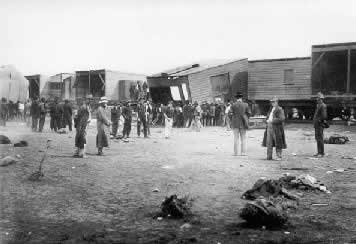When the Federation of Australian colonies was being considered Western Australia was the most reluctant colony. The Premier, (Sir) John Forrest, believed that a railway linking WA to the other states of Australia would help to unify the various Western Australian factions. In 1896, when the railway reached Kalgoorlie from Perth, Forrest promised the Goldfields residents that the railway would not stop at Kalgoorlie. This was a promise they did not let him forget.
Thus the lure of a trans-continental railway did become the 'carrot' which led WA to join the Federation of Australia on January 1st 1901. Unfortunately it was only a promise and not a cast iron guarantee. This resulted in many years of lobbying by Western Australia to see it come to fruition. Despite a preliminary survey in 1901 it was not until 1908 that WA and South Australia, each to their side of the border, undertook a full survey across the desert. But the enormous cost was a significant difficulty for the fledging nation.
Construction
of the Trans Australian Railway commenced at each end of the line and
the track finally joined about five years later in 1917. All supplies
had to be brought in and housing was moved from camp to camp.
Photograph: P Rogers Collection. Courtesy K McGurk
Following the visit of the Chief of the Imperial General Staff, Lord Kitchener in 1911, the Federal Parliament recognised the importance of the Trans line in the defence of the nation. Hence following the introduction of a bill into Federal Parliament by the Minister for Home Affairs, King O'Malley, a vote for the new Transcontinental Railway was passed on 6th December 1911. Construction of the 1051 miles (1692 km) standard gauge railway, to run from Kalgoorlie to Port Augusta commenced in 1912. For the Commonwealth of Australia, the Trans-Australian Railway (TAR) was its first venture into railways. Once construction was underway the new entity to be known as the Commonwealth Railways was created.
Despite problems with labour and supplies due to the 1914-1918 war, construction was completed on 17th October 1917 at a point near Ooldea. One team had worked from the eastern end (starting from Port Augusta) and the other from the western end (Kalgoorlie). These teams had to be equipped not only with the materials to build the railway but also with food, water, accommodation and other supplies for the workers. Despite all tribulations and the great distances, when the two teams met they were less than a metre apart on a north-south line. This made the final joining of the rails very easy.
The Trans Australian Railway was to fulfill Kitchener's prediction of its importance for Australia's defence during World War II. During the years 1942-44 the railway was generally unavailable for any non-military use, due to its vital role in the transport of troops and equipment.
However it was not until the late 1960s that a standard gauge railway was built between Kalgoorlie and Perth. Until then passengers and freight suffered the 'break of gauge experience', that is a change of trains at Kalgoorlie.
Back to Early Travels
